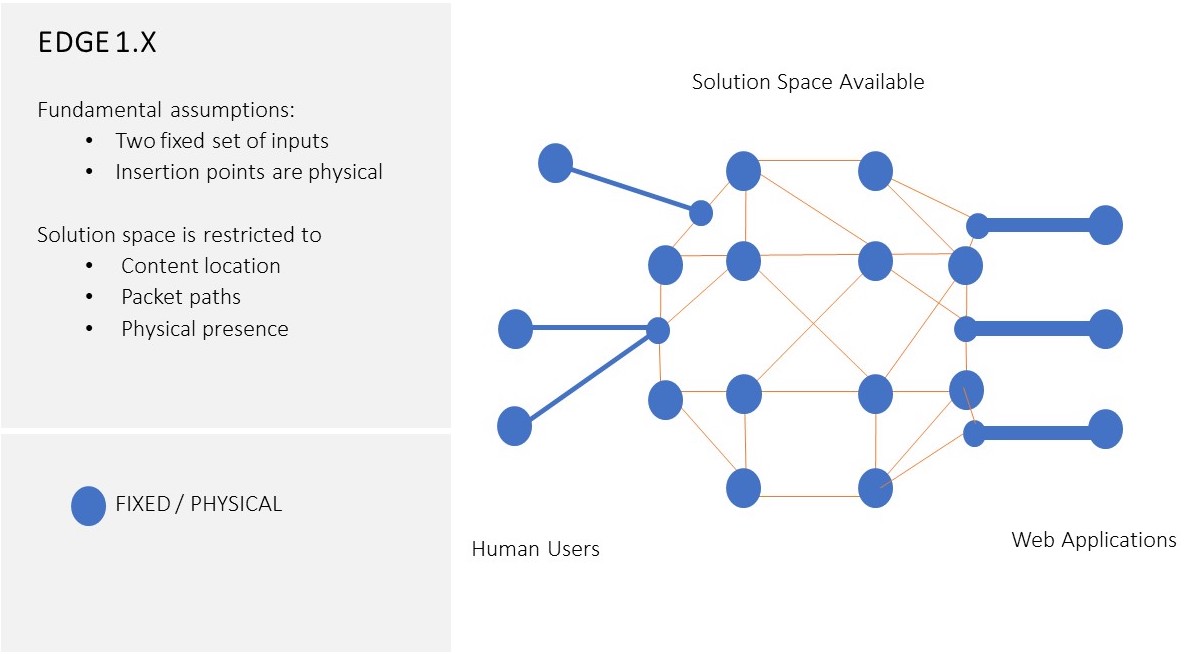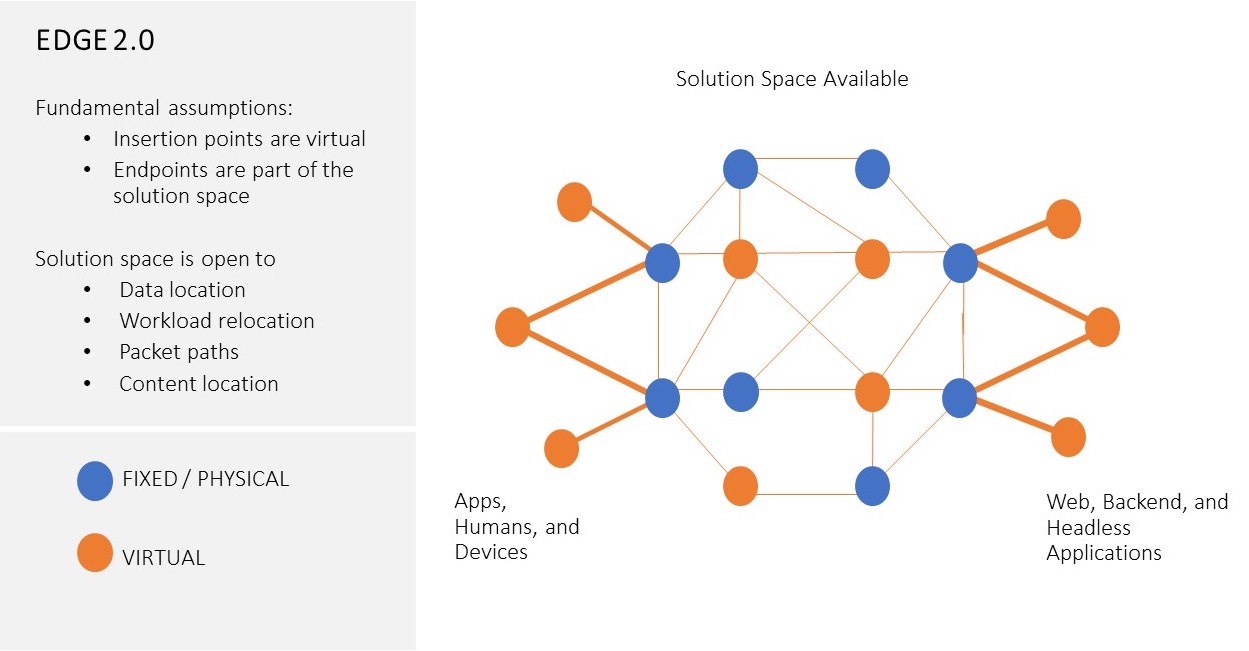Manifeste Edge 2.0 : Redéfinir l'informatique de pointe
L'achèvement de l' acquisition de Volterra par F5 marque le début de la prochaine phase de l'edge computing, inaugurant l'ère Edge 2.0 . Nous prévoyons qu’à l’ère Edge 2.0, les entreprises numériques de tous les secteurs d’activité adopteront des plateformes informatiques de pointe pour fournir des applications et traiter et analyser les données. La plateforme Edge sera un élément essentiel de l’expérience utilisateur pour tous les services numériques.
Dans cet article, j’expliquerai l’évolution de l’architecture Edge et discuterai de la vision technologique de F5 pour le paradigme Edge 2.0.
Bord 1.0
Les technologies de pointe existent sous une forme embryonnaire depuis de nombreuses années, mais avec une orientation différente. Au début de l’émergence d’Internet, l’accent était mis sur le contenu statique et était appelé Content Delivery Network (CDN). Tim Berners-Lee, l'inventeur du World Wide Web, a anticipé le problème de congestion lié au passage de grandes quantités de contenu Web sur des liens lents auquel les utilisateurs d'Internet seraient confrontés : il a appelé ce problème « l'attente mondiale ». Intrigué par ce défi, le professeur du MIT Tom Leighton a exploré le problème à travers des recherches universitaires. Lui et son étudiant Danny Lewin ont ensuite cofondé Akamai Technologies en 1998, qui a créé le paradigme de l'architecture Content Delivery Network.
L’objectif du paradigme CDN était, à juste titre, de distribuer du contenu Web ou des applications Web relativement statiques pour les rapprocher des utilisateurs afin de répondre au besoin de vitesse et de redondance. Ce besoin a conduit à un ensemble de principes d’architecture clés, notamment un point de présence physique (PoP) à proximité des utilisateurs finaux, la mise en cache de contenu, la prédiction de localisation, l’évitement de la congestion, les algorithmes de routage distribués, etc. Bien que les réseaux et les appareils aient changé, ces principes de conception dominent toujours les architectures CDN fondamentales aujourd’hui.
Bord 1.5
Entre-temps, l’écosystème du « contenu » Internet a évolué. Les applications sont devenues la principale forme de contenu sur Internet. Ainsi, le edge distribué ne pouvait pas persister dans sa forme naissante : il devait évoluer avec les architectures d’application qu’il fournissait, tout en étant soumis à une pression croissante pour sécuriser une économie numérique en pleine croissance. Alors qu'une grande partie de l'économie mondiale dépend désormais fortement des applications centrées sur le commerce, les services de sécurité sont rapidement devenus un élément de base complémentaire des fournisseurs de CDN, dont la présence existante dans le monde entier s'étendait plus près de l'utilisateur (et résolvait donc les menaces plus tôt) que le cloud et le centre de données traditionnel. Ces services ont été construits sur l’infrastructure mise en place pour distribuer du contenu et représentent donc des environnements fermés et propriétaires. Les services offerts par un fournisseur CDN ne sont ni compatibles ni transférables vers un autre.
De plus, les principes de conception fondamentaux du paradigme d'architecture CDN d'origine, visant à résoudre le défi original de Tim Berners-Lee sur Internet, « World Wide Wait », supposaient que les deux ensembles de points de terminaison (les utilisateurs et le contenu auquel ils accèdent) sont des entités relativement passives, et reléguaient la solution au problème principalement à un niveau intermédiaire : dans ce cas, un CDN. L’évolution de l’écosystème Internet, en particulier le passage aux applications de microservices basées sur des conteneurs et à l’informatique intelligente pour l’utilisateur final, a complètement brisé cette hypothèse. Voir la figure 1 pour une vue conceptuelle de la sphère architecturale Edge 1.x. Nous reviendrons sur ces deux facteurs plus en détail dans la section suivante.

Catalyseurs de l'évolution des périphériques
Même si les entreprises doivent toujours distribuer du contenu statique, elles se tournent également vers l’Edge pour jouer un rôle plus important dans leur architecture applicative. Les dernières recherches menées par F5 montrent que 76 % des entreprises interrogées prévoient d'utiliser Edge pour divers cas d'utilisation, notamment l'amélioration des performances, l'accélération de la collecte et de l'analyse des données, la prise en charge de l'IoT et l'utilisation de capacités de traitement en temps réel ou quasi réel. Cela inclut 25 % des entreprises qui ne prévoient aucun rôle dans leur infrastructure pour les services d’une simple fonction CDN. Ces organisations créent des applications hautement dynamiques, distribuées à l’échelle mondiale, avec des expériences utilisateur sécurisées et optimales. Ils se tournent vers Edge pour fournir la présence et la flexibilité des services d’application multi-sites et les éléments de base cohérents dont ils ont besoin pour le faire avec succès.
Aujourd’hui, nous constatons que les services proposés par les fournisseurs Edge dotés d’une architecture centrée sur le CDN, comme Akamai, Fastly et Cloudflare, ne disposent pas des caractéristiques de base nécessaires pour fournir ces capacités centrées sur les applications. Par exemple, avec les applications distribuées basées sur Kubernetes, la logique d’application, regroupée dans un conteneur, peut se déplacer dynamiquement vers n’importe quel emplacement de calcul approprié avec une pile Kubernetes de prise en charge. Il peut le faire, dans le but d’optimiser l’expérience utilisateur, que l’emplacement de calcul soit une instance IaaS d’un cloud public, un serveur physique appartenant à l’entreprise ou une machine virtuelle dans le PoP du fournisseur Edge. Ainsi, les applications ne sont plus les destinations de routage « passives » du réseau de distribution, mais sont plutôt des participants actifs de la solution Edge. Cela est en contradiction directe avec les principes d’architecture sur lesquels les solutions Edge de ces fournisseurs de CDN ont été construites. Autrement dit, nées à une époque où les contenus (ou les applications) étaient des entités statiques associées à des emplacements physiques, leurs solutions de périphérie présupposaient que le réseau de diffusion de contenu fonctionnait seul comme la « plate-forme intelligente » pour connecter les utilisateurs aux applications, tandis que les applications (et les utilisateurs) restaient des « points de terminaison » passifs de la « plate-forme intelligente ». Cette approche n’est plus la meilleure façon architecturale de connecter les utilisateurs au contenu ou aux applications.
Il ne s’agit pas seulement d’applications. Les utilisateurs ont également évolué. Non seulement leur sophistication numérique et leur appétit pour l’engagement numérique sont à des années-lumière de ce qu’ils étaient lorsque Akamai a démarré en 1998, mais la technologie a forcé un changement dans la définition de ce qu’ils sont. Aujourd’hui, un « utilisateur » peut très bien être une machine, un script ou un service automatisé agissant pour le compte d’un humain. Il peut s’agir d’un capteur collectant des données critiques provenant d’une usine de fabrication ou d’un champ agricole. D’un côté, ces « utilisateurs » continuent de véhiculer les mêmes désirs de rapidité, de sécurité et de confidentialité que leurs homologues humains. D’autre part, ces nouveaux « utilisateurs » (des points de terminaison IoT intelligents dotés de piles d’applications intégrées) participent souvent au traitement dynamique de la logique applicative et de l’analyse des données pour offrir des expériences numériques utilisateur sécurisées et optimales. Ils sont eux-mêmes devenus hôtes de certaines fonctions applicatives pour aider à optimiser les expériences numériques. Par exemple, avec WebAssembly exécuté sur un appareil d’utilisateur final intelligent, il est devenu possible pour le point de terminaison de participer plus pleinement aux fonctions de sécurité des applications (par exemple, le pare-feu d’application) ou à l’analyse des données d’application.
Ces deux méga-changements à l’échelle de l’industrie (applications distribuées modernes basées sur des conteneurs et points de terminaison intelligents) s’intègrent rapidement dans les solutions Edge avancées, en remplacement du seul ancien réseau de diffusion de contenu. Les principes d’architecture des solutions CDN ou Edge 1.x centrées sur le contenu, qui reposent sur la résolution des défis de diffusion de contenu associés à un écosystème Internet vers 2000, ne sont plus adaptés pour résoudre les défis des applications distribuées à l’échelle mondiale et des expériences numériques du futur. L’industrie a besoin d’un nouveau paradigme Edge : un paradigme Edge 2.0. Voir la figure 2 pour une vue conceptuelle de la sphère d’architecture Edge 2.0.

En termes commerciaux, les dirigeants d’entreprise informatiques et numériques d’aujourd’hui aimeraient voir la distribution et la sécurité des applications Edge devenir partie intégrante de leur pipeline numérique et de leur processus de production. Cela permettra à leurs applications d’être « construites une fois, livrées partout » dans le monde avec la même expérience utilisateur transparente, sécurisée et optimisée. Les « services d'application » centrés sur le CDN des fournisseurs Edge existants (Akamai, Fastly et Cloudflare) obligent les entreprises à réorganiser minutieusement leurs applications et à s'adapter à la conception, aux emplacements, aux services et aux outils du fournisseur Edge centré sur le CDN. Les architectures d’application qui en résultent ne s’intègrent pas facilement dans les flux de travail DevOps et informatiques de l’entreprise qui pilotent le déploiement et le fonctionnement de ses charges de travail. Ainsi, ces « services d'application » ancrés dans les systèmes et services fermés centrés sur le CDN introduisent un autre obstacle opérationnel dans la quête de l'entreprise pour une solution multicloud transparente pour une distribution d'applications appropriée et efficace.
Edge 2.0
Les principaux défis applicatifs pour lesquels Edge est apparu (vitesse puis sécurité) existent toujours aujourd’hui. Ce qui a changé, c'est la définition de l'application (d'une instance statique résidant dans un emplacement fixe à des unités de conteneurs « mobiles »), de l'utilisateur (d'un utilisateur humain à une « chose » intelligente) et de l'emplacement (d'une adresse IP à une identification logique). La numérisation des entreprises, considérablement accélérée par la COVID et qui touche tous les secteurs d’activité, donne naissance à une nouvelle classe d’expérience numérique qui ne peut être abordée simplement en rapprochant le contenu de l’utilisateur. Cela nécessite un nouveau paradigme Edge, centré sur la distribution holistique des applications et basé sur un ensemble différent de principes de conception technologique : le paradigme Edge 2.0.
Edge 2.0 a été conçu en pensant aux utilisateurs et aux applications modernes. Nous combinons les ressources des clouds publics, du cloud privé sur site client ou des centres de données, ainsi que des machines bare metal ou appareils intelligents situés à distance pour étendre virtuellement cette présence élastique à la demande. Nous adoptons des méthodes modernes de développement et de déploiement pour offrir une gestion intégrée du cycle de vie des applications et permettre aux équipes DevOps d’obtenir une visibilité mondiale. Concernant la sécurité des applications, Edge 2.0 abandonne les défenses traditionnelles basées sur le périmètre au profit d’un système intégrant la sécurité directement dans la plateforme Edge, avec des outils intégrés pour protéger la confidentialité. Nous séparons les lieux de traitement et d’analyse des données de celui de la logique applicative, tout en appliquant les politiques d’entreprise à l’ensemble. Edge 2.0 détecte aussi quand des charges de travail exigent un traitement spécifique et les oriente vers le matériel spécialisé approprié pour maximiser l’efficacité. Vous pilotez tout cela depuis un plan de contrôle unifié.
Le La plateforme Edge 2.0 repose sur les principes de conception clés suivants :
- Plan de contrôle unifié
Edge peut inclure n’importe quel environnement, y compris les points de terminaison utilisateur et les clouds publics. Un plan de contrôle unifié garantit la définition commune des politiques de sécurité, des politiques de localisation des données et de la gestion des identités des utilisateurs dans différents environnements et impose l'exécution via l'intégration avec des outils d'automatisation et d'orchestration.
- Orientée application
La plateforme Edge 2.0 s’intègre parfaitement aux outils de gestion du cycle de vie des applications. Vous déclarez les politiques de sécurité applicative, les règles de localisation des données, la gestion des identités et l’orchestration des ressources via le plan de contrôle unifié, que nous appliquons dans tout environnement où la plateforme s’exécute. Edge devient une « propriété déclarée » de votre application cible (chaque application dispose donc de son propre Edge « personnalisé ») que la plateforme exécute automatiquement, sans intervention manuelle. Vous pouvez ainsi vous concentrer sur la logique de votre application, ses interactions (API) et vos processus métier, sans vous soucier de gérer l’infrastructure ni les emplacements.
- Sécurité distribuée intégrée à la plateforme Edge
Dans la plateforme Edge 2.0, les politiques de sécurité des applications sont définies de manière commune via le plan de contrôle unifié. Ils sont distribués pour être appliqués dans chaque environnement dans lequel l'application s'exécute. Les fonctionnalités de sécurité intégrées directement dans la plateforme (par exemple, le chiffrement, la meilleure détection de BOT) permettent à ces fonctions de sécurité de se déplacer avec l'application par défaut.
- Traitement de données distribué et analyse intégrée
La plateforme Edge 2.0 devient une structure globale pour la logique applicative et une structure globale pour le traitement et l’analyse des données. Tout service numérique nécessite à la fois des données et une logique d’application, mais l’emplacement de stockage, de traitement et de transformation des données ne doit pas nécessairement être le même que celui où réside la logique d’application. L'emplacement des données doit être spécifié indépendamment sous la forme d'un ensemble de politiques au niveau de la plateforme déterminées par des facteurs tels que la gravité des données, les réglementations (PCI, GDPR, etc.) et le rapport prix/performance du traitement. Similaires aux politiques de sécurité, les politiques de localisation des données doivent être « déclarées » par les utilisateurs via le plan de contrôle unifié et appliquées par la plateforme dans n’importe quel environnement. La plateforme Edge 2.0 a également un rôle à jouer dans d'autres politiques de gestion des données, telles que la lignée des données, en stockant ces détails sur les données sous forme d'attributs intégrés, en plus d'avoir un ensemble de capacités opérationnelles intégrées pour l'observabilité, le streaming de télémétrie, les outils ML et les services ETL.
- Edge élastique défini par logiciel
Avec Edge 2.0, « Edge » ne se limite plus à des PoP physiques situés dans des lieux précis. Il se définit désormais de façon dynamique via le plan de contrôle Edge 2.0, autour des ressources que vous souhaitez déployer : dans des clouds publics, hyperviseurs, centres de données ou clouds privés, voire sur des machines physiques dans des sites « distants » propres à votre entreprise. Les capacités réseau de connexion reposent aussi sur une approche définie par logiciel, qui surmonte n’importe quelle infrastructure WAN privée ou publique, sans que vous ayez à fournir d’efforts considérables pour assembler ou configurer. Nous adaptons le Edge élastique défini par logiciel en fonction de la déclaration d’intention de votre application cible. Le « Edge » – et tout ce qu’il met en place pour votre application au moment de cette déclaration – devient une fonctionnalité simple et facile à utiliser intégrée à votre application.
- Calcul optimisé pour le matériel
Les progrès dans les processeurs et chipsets—en particulier les GPU, DPU, TPU et FPGA dont les capacités ne cessent de croître—nous permettent d’optimiser significativement l’utilisation des ressources pour des types spécifiques de charges de travail. Une plateforme Edge 2.0 se connectera aux systèmes équipés de ce matériel spécialisé pour cibler, déployer et exécuter des charges de travail applicatives qui tireront pleinement parti de ce soutien. Par exemple, elle identifiera et configurera les ressources GPU pour les charges de travail intensives en IA/ML, ou localisera et intégrera un DPU pour les services spécialisés de sécurité applicative et réseau dont votre application a besoin. La prise en compte du matériel par Edge 2.0 ouvre des perspectives passionnantes pour créer des « systèmes industriels » intelligents dédiés aux applications, offrant ainsi des possibilités infinies pour concevoir des solutions IoT performantes nécessitant un traitement en temps réel localement. Par exemple, une borne de recharge pour véhicules électriques peut faire office de point d’agrégation pour les nombreux flux de données générés par les capteurs du véhicule, tandis qu’un véhicule autonome sous Android OS peut fonctionner comme un centre de données mobile réalisant en continu des autodiagnostics assistés par matériel. Nous envisageons que la plateforme Edge 2.0 prendra en charge tous ces systèmes intelligents à usage spécifique pour enrichir et améliorer les expériences numériques globales que vous vivez.
Conclusion
Edge 2.0 a été conçu avec la vision de résoudre le défi auquel sont confrontées les applications distribuées de demain en gardant à l’esprit des expériences numériques mondiales transparentes. Nous ne sommes plus en 1998. L’écosystème Internet, le cloud computing et la transformation numérique ont désormais évolué considérablement au-delà de ce que l’on pouvait imaginer lorsque le modèle d’architecture CDN a été conçu pour la première fois. En reconnaissant qu’il ne s’agit pas seulement d’un monde multi-cloud mais aussi d’un monde numérique omniprésent, le paradigme Edge 2.0 cherche à résoudre les défis du futur en éliminant les hypothèses limitatives du passé. Il promet de permettre une véritable portabilité des applications dans n’importe quel environnement ainsi que les services dont elles ont besoin pour fonctionner avec succès, en toute sécurité, rapidement et avec des expériences utilisateur transparentes.
Avec la récente acquisition de Volterra, F5 est dans la position idéale pour diriger la création de ce paradigme Edge 2.0 centré sur les applications.
